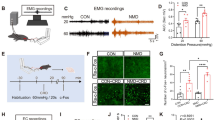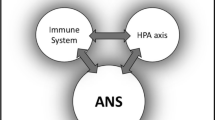Abstract
Systemic administration of caerulein (10–100 µg/kg SC), a potent analogue of cholecystokinin, caused a profound dose-related depression of variable-interval self-stimulation, followed by progressive recovery within 60 min. Intracerebroventricular injection of caerulein (3–1000 ng) was not more effective than systemic injection, while injections into the nucleus accumbens (3–100 ng bilaterally) were without detectable effect. Systemic injections of L-364,718 (70–700 µg/kg IP), a specific competitive antagonist of CCKA (“peripheral-type”) receptors, had no effect on self-stimulation when given alone. When given in combination with caerulein, L-364,718 (200 µg/kg IP) significantly reduced the inhibitory effect of caerulein (30 µg/kg SC); however, this dose, and higher doses of L-364,718, failed to confer complete protection. It is concluded that self-stimulation performance may be subject to modulation by CCK receptors distributed predominantly in the peripheral nervous system and that some but not all of these receptors are CCKA receptors.
Similar content being viewed by others
References
Altar CA, Boyar WC (1989) Brain CCK-B receptors mediate the suppression of dopamine release by cholecystokinin. Brain Res 483:321–326
Crawley JN (1985) Cholecystokinin potentiates dopamine-mediated behaviours in the nucleus accumbens, a site of CCK-DA co-existence. Psychopharmacol Bull 21:523–527
Crawley JN, Beinfeld MC (1983) Rapid development of tolerance to the behavioural actions of cholecystokinin. Nature 302:703–706
Deutsch JA (1983) Dietary control and the stomach. Prog Neurobiol 20:313–322
Dourish CT, Hill DR (1987) Classification and function of CCK receptors. TIPS 8:207–208
Ellinwood EH, Rockwell K, Wagoner N (1983) Apomorphine behavioral effect is facilitated by dibutyryl cyclicAMP and inhibited by caerulein. Psychopharmacol Bull 19:352–354
Ettenberg A, Koob GF (1984) Different effects of cholecystokinin and satiety on lateral hypothalamic self-stimulation. Physiol Behav 32:127–130
Fekete M, Rentsch A, Schwartzberg H, Telegdy G (1983) Effects of cholecystokinin on self-stimulation behaviour in rats. Eur J Pharmacol 90:77–82
Gibbs JG, Young RC, Smith GP (1973) Cholecystokinin decreases food intake in rats. J Comp Physiol Psychol 84:488–495
Gower AJ, Broekkamp CLE (1985) Central versus peripheral CCK-8 in self-stimulation and locomotor activity in the rat. Ann NY Acad Sci 448:604–606
Hamilton MH, de Belleroche JS, Herberg LJ (1984) Subcutaneous and intraventricular caerulein reduces intracranial self-stimulation. Neurosci Lett (Suppl) 18:S38
Hamilton MH, Sheehan MJ, de Belleroche JS, Herberg LJ (1984a) The cholecystokinin analogue, caerulein, does not modulate dopamine release or dopamine-induced locomotor activity in the nucleus accumbens of rat. Neurosci Lett 44:77–82
Herberg LJ, Williams SF (1983) Anti-conflict and depressant effects by GABA agonists and non-gabergic anticonvulsants on self-stimulation and locomotor activity. Pharmacol Biochem Behav 19:625–633
Hill DR, Woodruff GN (1988) Brain CCK receptors. Proc. CCK'88, Cambridge
Kornblith CL, Ervin GN, King RA (1978) Hypothalamic and locus coeruleus self-stimulation are decreased by cholecystokinin. Physiol Behav 21:1037–1041
Le Sauter J, Goldberg B, Geary N (1988) CCK inhibits real and sham feeding in gastric vagotomised rats. Physiol Behav 44:527–534
Lotti VJ, Chang RSL (1989) A new potent and selective non-peptide gastrin antagonist and brain cholecystokinin receptor (CCK-B) ligand L-365,260. Eur J Pharmacol 162:273–280
Nazzaro J, Gardner EL (1980) Gaba antagonism lowers self-stimulation thresholds in the ventral tegmental area. Brain Res 189:279–283
Pellegrino LJ, Pellegrino AS, Cushman AJ (1979) A stereotaxic atlas of the rat brain. Plenum Press, New York
Pellow S (1985) Can drug effects on anxiety and convulsions be separated? Neurosci Biobehav Rev 9:55–73
Rattray M, Jordan CC, de Belleroche J (1988) The novel CCK antagonist L-364,718 abolishes caerulein- but potentiates morphine-induced antinociception. Eur J Pharmacol 152:163–166
Rose IC, Mintz M, Herberg LJ (1988) Chronic L-DOPA fails to lessen rebound enhancement of self-stimulation after chronic haloperidol. Pharmacol Biochem Behav 30:585–588
Sheehan MJ, de Belleroche JS (1985) Naloxone potentiation of the antinociceptive actions of caerulein. Ann NY Acad Sci 448:642–647
Stephens DN, Herberg LJ (1977) Effects of hypothalamic self-stimulation of drugs influencing dopaminergio neurotransmission injected into nucleus accumbens and corpus striatum of rats. Psychopharmacology 54:81–85
Vaccarino FJ, Koob GF (1984) Microinjection of nanogram amounts of sulfated cholecystokinin octapeptide into the rat nucleus accumbens attenuates brain stimulation reward. Neurosci Lett 52:61–66
Van Ree JM, Gaffori O, DeWied D (1983) In rats, the behavioural profile of CCK-8 related peptides resembles that of antipsychotic agents. Eur J Pharmacol 93:63–78
Wauquier A (1979) Neuroleptics and brain self-stimulation behaviour. Int Rev Neurobiol 21:335–403
Winsauer PJ, Riley AL (1988) Cholecystokinin potentiates the decreasing effects of morphine on schedule-controlled behavior in rats. Pharmacol Biochem Behav 30:569–575
Wise RA (1978) Catecholamine theories of reward — a critical review. Brain Res 152:215–247
Zetler G (1979) Antagonism of cholecystokinin-like peptides by opioid peptides, morphine or tetrodotoxin. Eur J Pharmacol 60:67–77
Zetler G (1980) Analgesia and ptosis caused by caerulein and cholecystokinin octapeptide (CCK-8). Neuropharmacology 19:415–422
Zetler G (1981) Central depressant effects of caerulein and cholecystokinin octapeptide (CCK-8) differ from those of diazepam and haloperidol. Neuropharmacology 20:277–283
Author information
Authors and Affiliations
Rights and permissions
About this article
Cite this article
Hamilton, M.H., Rose, I.C., Herberg, L.J. et al. Effect of intracerebroventricular and systemic injections of caerulein, a CCK analogue, on electrical self-stimulation and its interaction with the CCKA receptor antagonist, L-364,718 (MK-329). Psychopharmacology 101, 384–389 (1990). https://doi.org/10.1007/BF02244058
Received:
Revised:
Issue Date:
DOI: https://doi.org/10.1007/BF02244058




